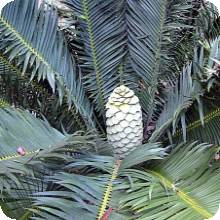|
| Division: Cycadophyta |
| Class: Cycadopsida |
| Order: Cycadales |
| Family: Zamiaceae |
| Genus: Encephalartos |
| Species: E. cerinus |
Conservation Status: |

E. cerinus
Waxen CycadE. cerinus, also known as the waxen cycad, is restricted to a single rocky gorge in the Tugela Ferry area of KwaZulu-Natal at an altitude of 900m. The locality is both hot and dry. Plants are scattered along an almost vertical rock face. It is a dwarf plant with a subterranean stem which may be partly exposed if growing in a rock crevice. Mature stems are 300mm long and 200mm to 250mm in diameter. It suckers or branches sparingly from the base.
E. cerinus has eight to ten leaves, 0.9m to 1.2m long with the median leaflets 13mm to 15mm long and 10mm to 12mm broad. The leaves are held almost vertical to the crown. The petiole or leaf stalk is 120mm to 180mm long and bare.
The pinnae are entire with occasionally one to two teeth on the lower margin of juvenile or seedling leaflets. The leaflets overlap from the middle of the leaf towards the top. The leaflets are blue green in colour and quite distinctive with a thick waxy covering. This covering leaves a very distinctive smell when rubbed. The latter fact gave rise to the specific epithet cerinus, meaning waxy. The cones of both sexes are solitary, although males in cultivation occasionally produce two or three together. The cones are blue green in colour, turning yellow at maturity. The cones likewise are covered with the thick waxy bloom so characteristic of this species. Male cones are 550mm to 600mm long and 80mm to 100mm in diameter. The median cone scales have a flattened terminal facet. The male cones are borne on an 80mm peduncle. The female cones are egg shaped, 300mm to 350mm long and 150mm to 180mm in diameter. The face of the female cone scales is smooth with a fringed lower edge. Seeds are 25mm long and 15mm in diameter and he sarcotesta is deep red.
Cultivation:
The fact that the species occurs mainly on sheer rock faces and steep rocky slopes means that good drainage and full sun are the prime cultural requirements. The leaf colour of plants in cultivation that have been grown in semi shade is green rather than blue. This species is easy to cultivate from seed.
| semi-shade | blue-green | low watering | slow growth | frost-resistant | common |
The fact that the species occurs mainly on sheer rock faces and steep rocky slopes means that good drainage and full sun are the prime cultural requirements. The leaf colour of plants in cultivation that have been grown in semi shade is green rather than blue. This species is easy to cultivate from seed.
E. cerinus for sale at AfricaCycads.com:
